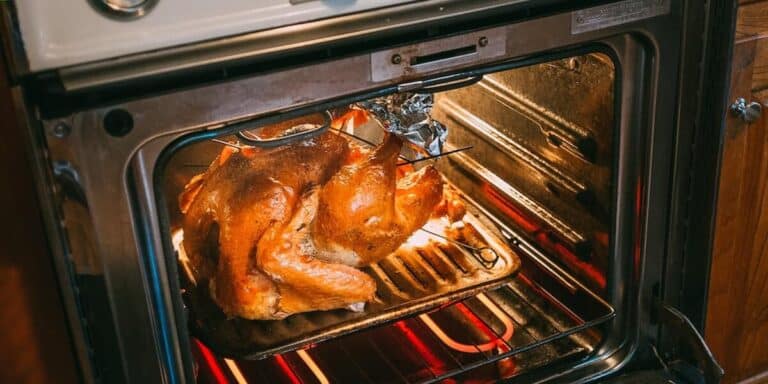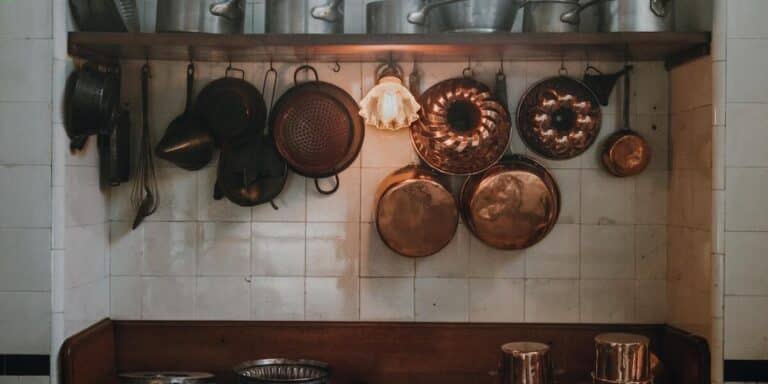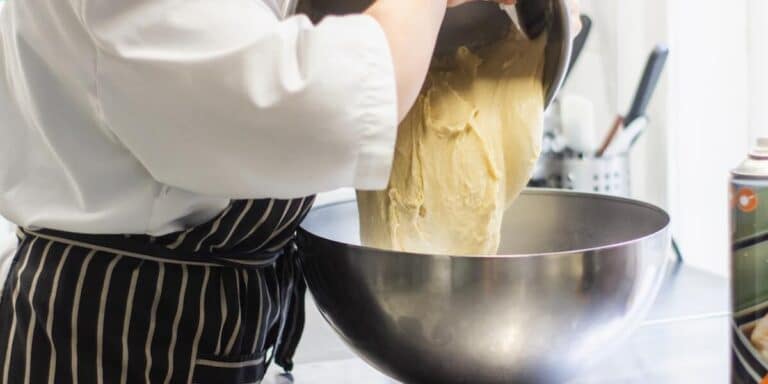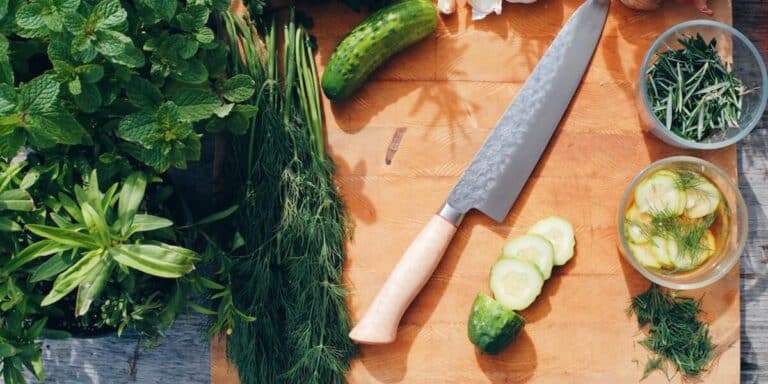Choosing the Right Baking Sheet
You’re in the market for a new baking sheet, but with so many options available, it’s hard to know where to start. You’ll want to take into account the type of baked goods you’ll be making most often, as well as how frequently you’ll be using the sheet. Your budget and available storage space will also come into play. As you weigh your options, you’ll need to think about the material, size, and special features that will make your baking tasks easier. But before you make a decision, there’s more to think about…
Key Takeaways
- Choose a baking sheet material that suits your needs, considering durability, heat conductivity, and non-stick coating.
- Select a baking sheet size that accommodates the quantity of baked goods you typically make, such as quarter, half, or full-sheet pans.
- Consider the thickness of the baking sheet, as it affects heat distribution and cooking performance, with lower gauges indicating thicker sheets.
- Think about the type of edge you need, with rimmed sheets ideal for messy bakes and rimless sheets suitable for delicate bakes.
- Prioritize ease of cleaning and maintenance, with non-stick coatings and dishwasher-safe options making post-baking cleanup simpler.
Material Options for Baking Sheets
Commonly, you’ll find that baking sheets are made from a variety of materials, each with its own advantages and disadvantages. You’ll want to weigh these factors when choosing the best baking sheet for your needs. Aluminum baking sheets are a popular choice because they’re lightweight, conduct heat well, and are generally less expensive than other materials. However, they can warp or bend easily, so you’ll need to handle them with care.
Stainless steel baking sheets are another option, offering durability and resistance to scratches and corrosion. They’re also easy to clean and maintain, making them a great choice for busy bakers. However, they can be more expensive than aluminum and may not conduct heat as well.
Non-stick baking sheets are coated with a layer of Teflon or other materials, making food release easy and cleanup a breeze. They’re perfect for delicate foods like eggs or crepes, but be careful not to scratch the surface, as this can damage the non-stick coating. You’ll also need to avoid using metal utensils or abrasive cleaners, which can damage the coating.
Copper baking sheets are a premium option, offering excellent heat conductivity and a beautiful appearance. However, they can be quite expensive and require regular maintenance to prevent oxidation. Ultimately, the choice of material will depend on your specific baking needs, preferences, and budget. By evaluating the pros and cons of each material, you’ll be able to choose the best baking sheet for your kitchen.
Importance of Thickness and Gauge
While choosing the right material for your baking sheet is important, you’ll also want to take into account its thickness, as it can greatly impact the sheet’s performance and durability. A thicker baking sheet will generally retain heat better, cook more evenly, and be less prone to warping or bending. On the other hand, a thinner sheet may heat up quickly, but it can also burn or warp just as fast.
When shopping for a baking sheet, you’ll often come across the term "gauge." Gauge refers to the thickness of the metal, with a lower gauge indicating a thicker sheet. For example, an 18-gauge baking sheet is thicker than a 20-gauge sheet. You’ll typically find baking sheets ranging from 18-gauge to 22-gauge. While a thicker gauge sheet is generally better, it’s also heavier and more expensive.
Baking Sheet Sizes and Options
Now that you’ve got a handle on the importance of thickness and gauge, it’s time to think about the size of your baking sheet. You’ll want to choose a sheet that fits your oven and suits the types of recipes you typically make. Whether you’re looking for a standard size or a specialty option, there are several key sizes and options to ponder.
Common Baking Sheet Sizes
Most baking sheets come in standard sizes, which you’ll want to contemplate when choosing the right one for your baking needs. You’ll often find quarter, half, and full-sheet pans, which are the most common sizes. Quarter-sheet pans are ideal for small batches of cookies or for roasting vegetables, while half-sheet pans are perfect for baking large quantities of cookies, bread rolls, or roasted meats. Full-sheet pans are the largest and are typically used for commercial baking or for big batches of cookies and pastries.
When choosing the right baking sheet size, consider the space you have available in your oven and the type of recipes you’ll be baking most often. If you have a compact oven, a quarter or half-sheet pan might be the best choice. On the other hand, if you have a large oven and like to bake in bulk, a full-sheet pan might be the way to go. By selecting the right size baking sheet, you’ll guarantee that your baked goods cook evenly and efficiently. This simple consideration will make a big difference in your baking experience.
Specialty Sheet Options
What happens when you need a baking sheet that doesn’t fit the standard quarter, half, or full-sheet sizes, or one with special features to tackle specific baking tasks? That’s where specialty sheet alternatives come in. You can find a variety of specialty baking sheets designed to help you tackle specific baking tasks or accommodate unique ingredients.
You might want to ponder a specialty sheet if you’re looking for a particular feature or functionality. Here are some examples of specialty sheet options:
- Air-insulated baking sheets: These sheets have a layer of air between two layers of metal, which helps with heat circulation and can lead to more evenly baked goods.
- Non-stick cookie sheets: These sheets are designed specifically for baking cookies and other delicate items that require easy release from the pan.
- Pizza stones with baking sheet inserts: These specialty sheets combine a pizza stone with a baking sheet to create the perfect setup for baking artisan-style pizzas.
- Flexible silicone mat-lined baking sheets: These sheets offer a flexible and non-stick surface perfect for baking delicate pastries or sugar-based desserts that can easily stick to a traditional metal surface.
Non-Stick Coatings and Benefits
You’re probably familiar with the frustration of baked goods sticking to your baking sheet. Non-stick coatings can be a game-changer, making food release and cleanup a breeze. Now, let’s explore the benefits of non-stick coatings and what factors affect their durability, so you can make informed decisions when choosing your next baking sheet.
Benefits of Non-Stick
Non-stick baking sheets offer a major advantage over their traditional counterparts: effortless food release, which makes cooking and cleaning a breeze. You’ll no longer have to scrub away at stubborn stuck-on food or worry about damaging the sheet.
Here are some benefits of non-stick baking sheets:
- Easy Food Release: Food slides off easily, reducing the risk of breakage or crumbling, especially delicate items like meringues or cakes.
- Cleaning Is a Snap: A quick wipe with a damp cloth and your sheet is good as new, saving you time and effort in the kitchen.
- Less Oil and Butter: With a non-stick surface, you can reduce the amount of oil or butter needed for cooking and baking, making for a healthier option.
- No Heavy Lifting: Because of the non-stick surface, food residue and stains won’t accumulate, making the sheets substantially more lightweight and easy to lift and store.
Coating Durability Factors
As you enjoy the benefits of effortless food release and easy cleaning with your non-stick baking sheets, it’s worth thinking about the factors that affect the durability of these coatings to guarantee they continue to perform well over time. The lifespan of your non-stick baking sheets depends on how well you maintain the coatings.
To extend the life of your non-stick coatings, avoid metal utensils, abrasive cleaners, and scouring pads. You’ll also want to line the baking sheets with parchment paper to minimize food residue and avoid exposure to high temperatures.
Common factors to take into account for maintaining durable coatings:
| Coating Durability Factors | Description | Benefits |
|---|---|---|
| Avoid Metal Utensils | Prevents | Boosts |
| scratches | lifespan | |
| No Abrasive Cleaners | Reduces wear | Preserves |
| and tear | non-stick | |
| Scouring Pads Prohibited | Prevents | Enhances |
| chip-off | cleaning | |
| Low-Temp Baking | Stops decay | Strengthens |
Insulation and Air Circulation Features
Some baking sheets come with features that enhance insulation and air circulation, helping you achieve evenly baked goods with a nice crust on the outside and a tender interior. When shopping for a baking sheet, you want to take into account these features, especially if you plan on baking delicate items like cookies or pastries.
Proper insulation and air circulation can make a huge difference in the outcome of your baked goods.
- Air-insulation technology: Some baking sheets have a layer of air trapped between two sheets of metal, which helps to distribute heat evenly and prevent hotspots.
- Perforations: Sheets with perforations or tiny holes allow air to circulate under your baked goods, promoting even browning and crisping.
- Non-stick coating with air pockets: Some baking sheets have a non-stick coating with tiny air pockets that help to distribute heat and air evenly.
- Thick-gauge construction: A thicker baking sheet retains heat better and cooks more evenly than a thinner one.
These features can help you achieve perfectly baked goods every time. No more burnt edges or undercooked centers! By choosing a baking sheet with insulation and air circulation features, you’ll be well on your way to becoming a baking pro. Just remember, the type of baking you plan to do most often should influence your choice of features.
Edge Types and Their Uses
What type of edge should your baking sheet have, and how will it affect the way you use it? When choosing a baking sheet, you’ll want to weigh the merits of the type of edge that suits your baking needs. There are two main types of edges: rimmed and rimless.
If you opt for a rimmed baking sheet, you’ll have a lip around the edge that prevents food from spilling over. This type of edge is perfect for messy bakes like roasted vegetables or juicy meats. The rim also makes it easier to handle the sheet, as you can grip it without worrying about food sliding off. On the other hand, rimmed sheets can be a bit more challenging to slide into a tight oven space.
Rimless baking sheets, on the other hand, have a flat, smooth edge. These sheets are ideal for delicate bakes like cookies or bread rolls, as they allow for easy transfer to a wire rack. Rimless sheets are also great for bakes that require a smooth, even surface, like tuiles or biscuits. However, you’ll need to be more careful when handling these sheets, as food can easily slide off.
Ultimately, the type of edge you choose will depend on the type of baking you do most often. If you’re a messy baker, a rimmed sheet might be the way to go. But if you’re working with delicate pastries, a rimless sheet is likely your best bet.
Baking Sheet Durability Factors
Now that you’ve got a sense of the different edge types and their uses, it’s time to think about what makes a baking sheet last. When you’re shopping for a new baking sheet, you’ll want to ponder the material it’s made of, how thick it is, and what kind of coating it has – all of these factors will impact its durability. By understanding how these elements interact, you’ll be able to choose a baking sheet that can withstand the rigors of frequent use.
Material Selection Matters
When it comes to baking sheets, the material you choose plays a significant role in determining durability and overall performance. You want a material that can withstand high temperatures, distribute heat evenly, and resist scratches and corrosion. Four key materials warrant consideration:
- Aluminum: Lightweight, conducts heat well, and is generally inexpensive. However, it can warp or bend under high heat.
- Stainless Steel: Durable, resistant to scratches and corrosion, and easy to clean. It can be noisy, though, and may require more oil for non-stick performance.
- Non-Stick Coated Steel: Food releases easily, and cleaning is a breeze. However, the non-stick coating can chip or flake off over time.
- Copper: Excellent heat conductivity, attractive appearance, and durable. However, it’s expensive and requires polishing to maintain its appearance.
When selecting a material, think about your baking style and priorities. If you value ease of cleaning, non-stick coated steel might be the way to go. If durability is your top concern, stainless steel could be the better choice. Ultimately, the right material will guarantee your baking sheet performs well and lasts long.
Thickness Affects Performance
Because thickness plays a crucial role in heat distribution and durability, choosing a baking sheet with the right gauge is essential for achieving peak performance. You’ll want to weigh the thickness of the baking sheet to guarantee it can withstand the rigors of frequent use.
A thicker baking sheet typically retains heat better, allowing for more even cooking and browning. On the other hand, a thinner sheet may warp or buckle under high temperatures, leading to uneven cooking and potential damage.
| Thickness | Heat Distribution | Durability |
|---|---|---|
| Thin (0.5 mm) | Poor | Low |
| Medium (1.0 mm) | Fair | Medium |
| Thick (1.5 mm) | Excellent | High |
| Extra-Thick (2.0 mm) | Superior | Very High |
When choosing a baking sheet, you should balance thickness with other factors such as material, size, and weight. A thicker sheet may be more durable, but it may also be heavier and more expensive. Ponder your specific needs and preferences to select the ideal thickness for your baking sheet. By doing so, you’ll be able to achieve perfect baked goods every time.
Coating Types Compared
In addition to thickness, another important factor affecting baking sheet durability is the type of coating used, which can substantially impact performance and longevity. When choosing a baking sheet, you’ll want to weigh the type of coating that’s right for you.
You’ve got several options to choose from, each with its own pros and cons. There are a few to ponder:
- Non-stick coating: Great for delicate foods that tend to stick, like eggs and pancakes. However, non-stick coatings can chip or flake off over time.
- Stainless steel coating: Durable and resistant to scratches and corrosion. However, it can be noisy and may react with acidic foods.
- Silicone coating: Flexible and non-stick, making food release easy. However, it may not be as durable as other options.
- Ceramic coating: Non-toxic and easy to clean, with a smooth surface for even baking. However, it can be prone to chipping.
Ultimately, the type of coating you choose will depend on your specific baking needs and preferences. By pondering your options carefully, you’ll be able to find a baking sheet that performs well and lasts long.
Ease of Cleaning and Maintenance
Cleaning and maintaining your baking sheets is easier than you think, especially if you choose sheets with a non-stick coating or durable, smooth finish that resists scratches and food residue. You’ll appreciate how quickly you can wipe them clean after use, saving you time and elbow grease. When food does stick, gentle scrubbing with a soft sponge and mild soap is usually all you need to remove it.
To make cleaning even simpler, you can line your baking sheets with parchment paper or a silicone mat. These prevent food from coming into contact with the sheet, eliminating stubborn stains and making cleanup a breeze. Additionally, many baking sheets are dishwasher safe, so you can toss them in the dishwasher for a hands-free cleaning. Just be sure to check the manufacturer’s instructions first to guarantee you’re not damaging the coating or other components.
Regular maintenance is also key to extending the life of your baking sheets. After cleaning, dry them thoroughly to prevent water spots. You can also lightly oil your sheets to maintain the non-stick coating and prevent rust. By choosing the right baking sheet and following these simple cleaning and maintenance tips, you’ll enjoy easy food release, reduced mess, and a longer-lasting baking sheet that will become a trusted companion in your kitchen.
Baking Sheet Storage and Organization
Now that you’ve got your baking sheets clean and well-maintained, it’s time to think about how you’ll store and organize them to keep your kitchen tidy and make them easy to access when you need them. A well-organized baking sheet storage system will save you time and hassle in the long run, and keep your sheets looking their best.
Four options are worth pondering:
- Wall-mounted rack: Install a rack on your kitchen wall or on the back of a door, and store your baking sheets vertically. This is a great space-saver, and keeps your sheets clean and dry.
- Drawer divider: Store your baking sheets in a dedicated drawer or cabinet, using dividers to keep them organized and prevent them from getting jumbled up.
- Cabinet organizer: Use an adjustable cabinet organizer to customize your storage space and make the most of your baking sheet collection.
- Under-sink rack: Install a rack or slide-out tray under your kitchen sink to store frequently used baking sheets, such as a quarter-sheet or half-sheet.
Whichever storage option you choose, make sure to dry and clean your baking sheets before storing them. This will prevent moisture from accumulating and reduce the risk of damage or rust. By organizing your baking sheet storage, you’ll save time, reduce clutter, and get baking with ease.
Price Points and Budget Considerations
Your budget for baking sheets will depend on several factors, including the type and quality of sheets you’re looking for, the frequency of use, and the storage solutions you’ve chosen. If you’re an occasional baker, you might be able to get by with a lower-cost, non-stick baking sheet. However, if you’re a serious baker or run a small bakery, you’ll want to invest in high-quality, durable baking sheets that can withstand frequent use.
The price range for baking sheets varies widely, from under $10 for a basic, non-stick sheet to over $50 for a heavy-duty, stainless steel sheet. You’ll also find mid-range options, such as silicone-coated or aluminum baking sheets, which offer a good balance between price and performance.
When setting your budget, take into account the cost per use. While a higher-end baking sheet may seem expensive upfront, it may last longer and perform better than a cheaper option. On the other hand, if you only bake occasionally, a lower-cost sheet might be sufficient. Additionally, if you have limited storage space, you may want to think about a baking sheet with a smaller footprint or a collapsible design. By weighing your needs and priorities, you can determine a budget that works for you and choose the right baking sheet for your needs. Ultimately, your budget for baking sheets will depend on your specific needs and preferences.
Specialty Baking Sheet Options
While you’re pondering your budget, you should also think about whether you need a specialty baking sheet that’s designed for a specific type of baking, such as cookie sheets, pizza stones, or jelly roll pans. These specialized sheets can make a big difference in the quality of your baked goods.
If you’re a serious baker, you might want to weigh investing in a few specialty sheets to help you achieve the best results. Here are a few options to weigh:
- Insulated cookie sheets: These sheets are designed to help cookies bake evenly and prevent them from burning.
- Pizza stones: These stones are perfect for baking pizzas, flatbreads, and other savory treats. They help to create a crispy crust and add flavor to your baked goods.
- Jelly roll pans: These pans are designed for baking thin cakes, such as jelly rolls and swiss rolls. They help to create a smooth, even texture and make it easy to roll up the cake.
- Air-insulated baking sheets: These sheets are designed to help with air circulation and even baking. They’re perfect for baking delicate pastries and other sweet treats.
Evaluating Your Baking Needs
To guarantee you’re selecting the right baking sheets for your needs, make certain to assess the types of baked goods you typically make and the frequency of your baking sessions. If you primarily bake sweet treats like cookies, cakes, and pastries, you’ll want baking sheets that can handle high temperatures and distribute heat evenly. On the other hand, if you mostly roast vegetables, meats, or seafood, you may prioritize baking sheets with a durable, non-stick coating that makes food release easy.
Consider how often you bake and the number of baked goods you typically make at one time. If you’re a frequent baker or like to make large batches, it’s worth investing in multiple baking sheets to save time and increase efficiency. If you only bake occasionally, a single, high-quality baking sheet might be sufficient. Also, think about the size of your oven and the space you have available for storing baking sheets when not in use.
Evaluating your baking needs also involves considering your personal preferences and cooking style. For instance, do you prefer easy clean-up or are you willing to scrub away at stubborn stains? Do you prioritize eco-friendliness or durability? By taking the time to assess your specific needs and priorities, you can choose baking sheets that suit your lifestyle and help you achieve the best possible results in the kitchen. By doing so, you’ll certify that your baking sessions are efficient, enjoyable, and produce delicious results.
Frequently Asked Questions
Is It Safe to Use Abrasive Cleaners on Baking Sheets?
You shouldn’t use abrasive cleaners on your baking sheets, as they can scratch the surface and create areas for bacteria to grow. Instead, you’ll want to stick with gentle soap and water or a soft cleanser.
Can I Put My Baking Sheet in the Dishwasher?
"Oh joy, you get to scrub away at last night’s lasagna! But seriously, don’t put your baking sheet in the dishwasher, as high heat and harsh detergents can damage its non-stick coating or warp its metal."
How Do I Prevent Baked Goods From Sticking to the Sheet?
You’ll want to prep your sheet by lightly greasing it with butter or cooking spray, or lining it with parchment paper to guarantee your baked goods release easily and don’t stick to the surface.
What Is the Best Way to Remove Stubborn Stains From Baking Sheets?
"Did you know 70% of baking sheets are trashed due to stubborn stains? Now, to tackle that problem: you’ll want to mix equal parts water and white vinegar in the stained area, let it sit, then scrub and rinse!"
Can I Use a Baking Sheet at Extremely High Oven Temperatures?
You’re probably wondering if you can use a baking sheet at extremely high oven temperatures. Honestly, it’s not recommended – most baking sheets warp or degrade above 450°F, so you’ll risk damaging yours if you do.






